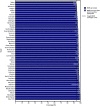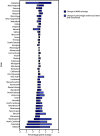Vaccination Coverage with Selected Vaccines and Exemption Rates Among Children in Kindergarten - United States, 2019-20 School Year
- PMID: 33476312
- PMCID: PMC7821768
- DOI: 10.15585/mmwr.mm7003a2
Vaccination Coverage with Selected Vaccines and Exemption Rates Among Children in Kindergarten - United States, 2019-20 School Year
Erratum in
-
Erratum: Vol. 70, No. 3.MMWR Morb Mortal Wkly Rep. 2021 Apr 2;70(13):501. doi: 10.15585/mmwr.mm7013a5. MMWR Morb Mortal Wkly Rep. 2021. PMID: 33793465 Free PMC article. No abstract available.
Abstract
State and local school vaccination requirements serve to protect students against vaccine-preventable diseases (1). This report summarizes data collected by state and local immunization programs* on vaccination coverage among children in kindergarten (kindergartners) in 48 states, exemptions for kindergartners in 49 states, and provisional enrollment and grace period status for kindergartners in 28 states for the 2019-20 school year, which was more than halfway completed when most schools moved to virtual learning in the spring because of the coronavirus 2019 (COVID-19) pandemic. Nationally, vaccination coverage† was 94.9% for the state-required number of doses of diphtheria and tetanus toxoids, and acellular pertussis vaccine (DTaP); 95.2% for 2 doses of measles, mumps, and rubella vaccine (MMR); and 94.8% for the state-required number of varicella vaccine doses. Although 2.5% of kindergartners had an exemption from at least one vaccine,§ another 2.3% were not up to date for MMR and did not have a vaccine exemption. Schools and immunization programs can work together to ensure that undervaccinated students are caught up on vaccinations in preparation for returning to in-person learning. This follow-up is especially important in the current school year, in which undervaccination is likely higher because of disruptions in vaccination during the ongoing COVID-19 pandemic (2-4).
Conflict of interest statement
All authors have completed and submitted the International Committee of Medical Journal Editors form for disclosure of potential conflicts of interest. No potential conflicts of interest were disclosed.
Figures


References
-
- Centers for Medicare & Medicaid Services. Coronavirus disease 2019 (COVID-19). Baltimore, MD: US Department of Health and Human Services, Centers for Medicare & Medicaid Services; 2020. https://www.medicaid.gov/resources-for-states/downloads/medicaid-chip-be...
-
- Mellerson JL, Street E, Knighton C, Calhoun K, Seither R, Underwood JM. Centers for Disease Control and Prevention’s school vaccination assessment: collaboration with US state, local, and territorial immunization programs, 2012–2018. Am J Public Health 2020;110:1092–7. 10.2105/AJPH.2020.305643 - DOI - PMC - PubMed
MeSH terms
Substances
LinkOut - more resources
Full Text Sources
Other Literature Sources
Medical

